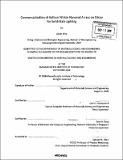Commercialization of gallium nitride nanorod arrays on silicon for solid-state lighting
Author(s)
Wee, Qixun
DownloadFull printable version (12.93Mb)
Other Contributors
Massachusetts Institute of Technology. Dept. of Materials Science and Engineering.
Advisor
Carl V. Thompson II and Soo-Jin Chua.
Terms of use
Metadata
Show full item recordAbstract
One important component in energy usage is lighting, which is currently dominated by incandescent and fluorescent lamps. However, due to potentially higher efficiencies and thus higher energy savings, solid-state lighting (SSL) is seriously being considered as a replacement. Currently, state-of-the-art white LEDs are made up of thin films of GaN and InGaN grown on sapphire substrates. A new LED structure design is proposed, in which GaN nanorod arrays are grown on silicon substrates. This new structure could be fabricated using anodized aluminum oxide's (AAO) ordered arrangement of pores as a template for growth of the nanorod array. AAO is selected for its high porosity and simple controllability of pore size and separation, which can in turn produce high density monocrystalline nanorod arrays with adjustable rod size and separation. Several advantages are enjoyed by LEDs based on rod arrays: lower cost, better yield and reliability and higher efficiencies. Two more LED designs, other than the current state-of-the-art GaN LED and the proposed LED structure, are included for comparisons. It is found that the proposed LED structure design is the best after considering costs and efficiency. For commercialization of this new LED design, the market penetration plan is to have a partnership with one of the major players in the current white LED industry. This has the advantage of having minimal capital investment and the product could be sold under an established brand. A simplified projection of earnings is calculated to illustrate sustainability of this business plan.
Description
Thesis (M. Eng.)--Massachusetts Institute of Technology, Dept. of Materials Science and Engineering, 2008. Includes bibliographical references (p. 37-40).
Date issued
2008Department
Massachusetts Institute of Technology. Department of Materials Science and EngineeringPublisher
Massachusetts Institute of Technology
Keywords
Materials Science and Engineering.